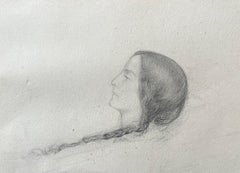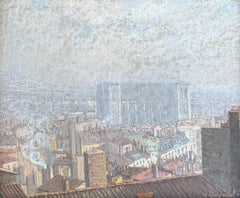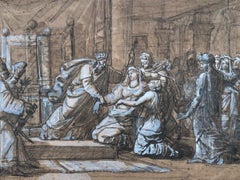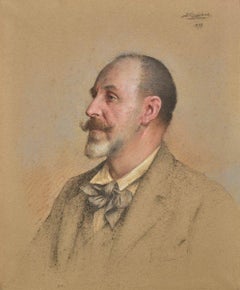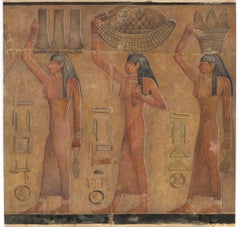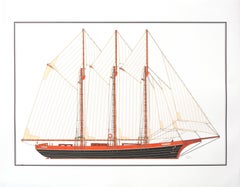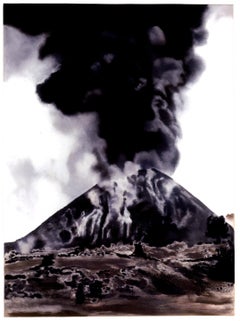GALERIE CHARVET Drawings and Watercolor Paintings
to
2
3
1
Overall Width
to
Overall Height
to
1
3
2
2
1
5
1
5
4
3
2
1
1
1
1
1
1
1
1
1
1
1
3
2
2
2
2
1
6
6
Study of woman figure
By Louis A. F. (Jean-Louis) Janmot
Located in PARIS, FR
Jean Louis Janmot (Lyon 1814 - 1892)
Study of woman figure
Black pencil
10,6 x 14,4 cm (26,6 x 30,2 x 6 cm with the frame)
Provenance : from the artist's series of drawings.
Wi...
Category
19th Century Figurative Drawings and Watercolors
Materials
Pencil
View Of Lyon On The Fourvière Hill 1938
Located in PARIS, FR
Henri Charles ANGENIOL (1870 - 1959)
View of Lyon from the Fourvière hill
Pastel
43.6 x 53.4 cm (47.3 x 57.4 cm with frame)
Signed and dated lower right (1938)
Category
1930s Landscape Paintings
Materials
Pastel
Neoclassical School 19th Century - Esther Fainting In Front Of Ahasuerus
Located in PARIS, FR
Neoclassical French school of the 19th century
Esther's fainting in front of Ahasuerus
Brown ink over black pencil lines with highlight in white gouache
31.5 x 42.3 cm (48.6 x ...
Category
19th Century Figurative Drawings and Watercolors
Materials
Paper, Ink, Gouache
French School of 18th Century - Study Of A Foot Skeleton
Located in PARIS, FR
French School, 18th century
Study of foot skeleton
Beautiful study in the period's frame.
Dimensions with frame 44 x 53 cm
Category
18th Century Still-life Drawings and Watercolors
Materials
Paper, Chalk
Portrait Of Louis Valayer, Mayor Of Avignon
Located in PARIS, FR
Delphin Enjolras (1865 - 1945)
Portrait Of Louis Valayer, Mayor Of Avignon From 1910 To 1919
Pastel on paper
Signed and dated top right : D. Enjolras 1899
Framed
Friend of the ...
Category
1890s Figurative Drawings and Watercolors
Materials
Paper, Pastel
Three Studies of Mastaba of Ty - Saqqara, Egypt
Located in PARIS, FR
Lucienne Épron grew up in the Charente Maritime in France, and was awakened to art under the influence of her tutors Felix Lionnet and Victor Richard, painters from Nantes. She follo...
Category
1930s Figurative Drawings and Watercolors
Materials
Watercolor
Related Items
"Freedom", Orange and Black Three-Masted Schooner Ink Drawing
By Philippe Mallet
Located in Clermont-Ferrand, Auvergne-Rhône-Alpes
This artwork depicts a three-masted schooner named Freedom, hailing from New-York. The boat has brown booms, masts, keel and bow, and black and orange hull...
Category
2010s Other Art Style Figurative Drawings and Watercolors
Materials
Paper, Ink
$594
H 21.66 in W 27.56 in
Volcano by Michele Zalopany black and white large scale landscape painting
By Michele Zalopany
Located in New York, NY
Executed in black, grey and brown, this monumental charcoal and pastel painting conveys the mythic drama and beauty of an active volcano. Rising in the shape of a wide, low cone, the...
Category
1980s Realist Landscape Paintings
Materials
Charcoal, Pastel
Italian School, Nicolo Grassi, 18th, Worship of Venus, The Venus Sacrifice, Amor
Located in Greven, DE
Italian School, 18th Century, Circle of Grassi,
This old master drawing is drawn in the late-Baroque or Rococo style.
It depicts a woman worshipping Venus/ preparing a sacrifice for ...
Category
Late 17th Century Baroque Figurative Drawings and Watercolors
Materials
Handmade Paper
$1,640 Sale Price
40% Off
H 8.9 in W 7.37 in
Mughal School, 18th century – Emperor Jahangir dancing with his harem attendees
Located in Middletown, NY
A joyful scene of lighthearted merriment in the palace of Jangahir Mahal Agra
Circa 1750. Gouache and ink with gold heightening on light weight cream laid paper, 8 1/4 x 6 inches (2...
Category
18th Century Rajput Figurative Drawings and Watercolors
Materials
Gold
$850
H 8.27 in W 6.03 in
Mughal School, 18th century Emperor Jahangir taking tea in his harem
Located in Middletown, NY
An illuminated page from a book likely in reference to palace life during Emperor Jahangir's reign over the Mughal Empire.
circa 1750. Gouache and ink with heightening in gold on li...
Category
18th Century Rajput Figurative Drawings and Watercolors
Materials
Gold
Fawn
By Henry Hablak
Located in Philadelphia, PA
"Fawn" is an original ink, colored pencil, and gouache on paper artwork by Henry Hablak measuring 30"h x 22"w.
Henry Hablak is a tattoo artist and illustrator based out of Philadel...
Category
2010s Contemporary Animal Drawings and Watercolors
Materials
Paper, Ink, Gouache, Color Pencil
Nur Jahan seated with a painted spice jar. Rajasthani School, 19th cent.
Located in Middletown, NY
Ink and gouache with gold heightening on fibrous, brown laid paper with a Jaipur Court Fee tax stamp in purple ink, 13 3/8 x 8 3/4 inches (340 x 222 mm). Toning, handling creases and...
Category
19th Century Rajput Figurative Drawings and Watercolors
Materials
Gold
$1,200
H 13.38 in W 8.75 in
Mughal School, 18th century Emperor Jahangir with Empress Nur Jahan on a Tiger
Located in Middletown, NY
circa 1750. Gouache and ink with heightening in gold on brown laid paper, 12 1/2 x 8 1/4 inches (317 x 210 mm), with a floral-motif border painted in blue and gold, the full sheet. With extensive inscriptions in Persian written in black ink on the verso. In good condition with extraordinary color. We see Empress Nur Jahan making an offering to a sage in his hut, as Emperor Jahangir looks on from a tree stand.
Nur Jahan was fond of hunting and often went on hunting tours with her husband and was known for her boldness in hunting ferocious tigers. She is reported to have slain four tigers with six bullets during one hunt. According to Sir Syed Ahmad Khan this feat, inspired a poet to declaim a spontaneous couplet in her honor: "Though Nur Jahan be in form a woman, In the ranks of men she...
Category
18th Century Rajput Figurative Drawings and Watercolors
Materials
Gold
$1,200
H 12.49 in W 8.27 in
Three Rajput noblemen on horseback – Rajasthani School, 19th century
Located in Middletown, NY
Ink and gouache with gold heightening on fibrous, brown laid paper, with a Jaipur Court Fee tax stamp in black ink on the recto, as well as the Jaipur City Council blindstamp, 13 5/8...
Category
19th Century Rajput Figurative Drawings and Watercolors
Materials
Gold
Raja Mahan Singh Mirpuri – Rajasthani School, 19th century
Located in Middletown, NY
Ink and gouache with yellow heightening on fibrous, brown laid paper with a Jaipur Court Fee tax stamp in blue ink, 13 1/2 x 8 3/4 inches (343 x 222 mm). Toning, handling creases and...
Category
19th Century Rajput Figurative Drawings and Watercolors
Materials
Gold
Contemporary Drawing "Blue Prayer" Draw, Pastel, Ink And Colored Pencils
Located in Bogotá, Bogotá
Drawing, pastel, Pencil, Petal Flowers, Color and Ink on Paper.
The base of this drawing is ordinary yellow paper of 80 gr. I use natural dyes from flowers, herbs, leaves, and tree ...
Category
2010s Contemporary Portrait Drawings and Watercolors
Materials
Paper, Pastel, Ink, Pencil, Color Pencil
"Baraques" ( near Deal, England) Pastel cm. 24 x 32 1910
By Edouard Chappel
Located in Torino, IT
landscape, fishing, England, 1910,pastel,green,blue
Edouard CHAPPEL (Anversa, 1859 – Cagnes-sur-Mer, 1946)
MUSEI
BELGIO
Anversa Musée Royal des Beaux-Arts
FRANCIA
Paris Musée d...
Category
1910s Impressionist Landscape Drawings and Watercolors
Materials
Pastel
$1,783
H 9.45 in W 12.6 in
